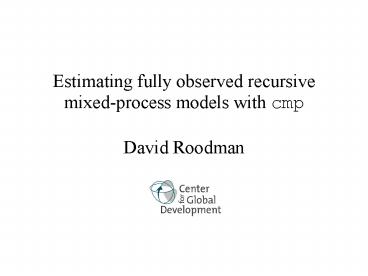Estimating fully observed recursive - PowerPoint PPT Presentation
Title:
Estimating fully observed recursive
Description:
Estimating fully observed recursive mixed-process models with cmp David Roodman * * * * * * * * * * * Probit model: Link function (g) induces likelihoods for each ... – PowerPoint PPT presentation
Number of Views:64
Avg rating:3.0/5.0
Title: Estimating fully observed recursive
1
Estimating fully observed recursive mixed-process
models with cmp David Roodman
2
(No Transcript)
3
(No Transcript)
4
Probit model Link function (g) induces
likelihoods for each possible outcome
5
Relabeling left graph for e scale error link
function (h) induces likelihoods for each
possible outcome
(h(e)g(x'ß e))
6
Just change g() to get new models
With generalization, embraces multinomial and
rank-ordered probit, truncated regression
7
Compute likelihood same way
- Given yi, determine feasible value(s) for e
- If just one, Li normal density at that point
- If a range, Li cumulative density over range
- For models that censor some observations (Tobit),
L? Li combines cumulative and point densities. - Amemiya (1973) maximizing L is consistent
8
Multiple equations (SUR)
For each obs, likelihood reached as before Given
y, determine feasible set for e and integrate
normal density over it Feasible set can be point,
ray, square, half plane Cartesian product of
points, line segments, rays, lines.
9
Bivariate probit
- Suppose for obs i, yi1 yi20
- Feasible range for e is
- Integral of fe(e)f(eS) over this
- Can use built-in binormal().
- Similar for y(0,1)', (1,0)', (1,1)'.
10
Mixed uncensored-probit
- Suppose for obs i, we observe some y(yi1, 0)'
- Feasible range for e is a ray
- Integral of fe(e)f(eS) over this
- Integral of 2-D normal distribution over a ray.
- Hard with built-in functions
- Requires additional math
11
Conditional modelingc in cmp
- Model can vary by observationdepend on data
- Worker retraining evaluation
- Model employment for all subjects
- Model program uptake only for those in cities
where offered - Classical Heckman selection modeling
- Model selection (probit) for every observation
- Model outcome (linear) for complete observations
- Likelihood for incomplete obs is one-equation
probit - Likelihood for complete obs is that on previous
slide - Myriad possibilities
12
Recursive systems
- ys can appear on RHS in each others equations
- Matrix of y coefficients must be upper triangular
- I.e. System must have clearly defined stages.
E.g. - SUR (several equations, one stage)
- 2SLS
- If system is fully modeled and truly recursive,
then estimation is FIML - If system has simultaneity and the early equation
stages instrument, then LIML
13
Fact
- If system is
- Recursive
- Fully observed (ys appear in RHS but never ys)
- then likelihoods developed for SUR still work
- Can treat ys in RHS just like xs
- sureg and biprobit can be IV estimators!
- Rarely understood, not proved in general in
literature - Greene (1998) surprisinglyseem not to be
widely known - Wooldridge (e-mail 2009) I came to this
realization somewhat late, although Ive known it
for a couple of years now. - I prove, perhaps not rigorously
- Maybe too simple for great econometricians to
bother publishing
14
General recursive, fully observed system
15
- cmp can fit
- conditional recursive mixed-process systems
- Processes Linear, probit, tobit, ordered probit,
multinomial probit, interval regression,
truncated regression - Can emulate
- Built-in probit, ivprobit , treatreg , biprobit,
oprobit, mprobit, asmprobit, tobit, ivtobit,
cnreg, intreg, truncreg, heckman, heckprob - User-written triprobit, mvprobit, bitobit,
mvtobit, oheckman, (partly) bioprobit
16
(No Transcript)
17
Emulation examples
18
Heteroskedasticity can make censored models not
just inefficient but inconsistent
Tobit example error variance rises with x
19
Implementation innovation ghk2()
- Mata implementation of Geweke-Hajivassiliou-Keane
algorithm for estimating cumulative normal
densities above dimension 2. - Differs from built-in ghkfast()
- Accepts lower as well as upper bounds
- E.g., integrate over cube a1,b1 a2,b2
a3,b3 - (otherwise requires 23 calls instead of 1)
- Optimized for many observations few simulation
draws/observation - Does not pivot coordinates. Pivoting can
improve precision, but creates discontinuities
when draws are few. (ghkfast() now lets you turn
off pivoting.)
20
Implementation innovation lfd1
- In Stata ML, using an lf likelihood evaluator
assumes that (A1) for each eq, - ml computes numerically with 2 calls per eq,
- then analytically.
- And for Hessian, of calls is quadratic in of
eq - Using a d1 evaluator, ml does not assume A1.
- But does (A2) require evaluator to provide
scores - For Hessian, of calls in linear in of
parameters - Two unrelated changes create unnecessary
trade-off - ml is missing an lfd1 type that assumes A1 and
A2would make Hessian with of calls linear in
of eq. - Solution pseudo-d2. d2 routine efficiently takes
over (numerical) computation of Hessian - Good for score-computing evaluators for which
21
Possible extensions
- Marginal effects that reflect interactions
between equations - (Multi-level) random effects
- Dropping full observabilityys on right
- Rank-ordered multinomial probit
22
(No Transcript)
23
References
- Roodman, David. 2009. Estimating fully observed
recursive mixed-process models with cmp. Working
Paper 168. Washington, DC Center for Global
Development. - Roodman, David, and Jonathan Morduch. 2009. The
Impact of Microcredit on the Poor in Bangladesh
Revisiting the Evidence. Working Paper 174.
Washington, DC Center for Global Development.































